
|
|
Wil Cleveland, E. Don Petit and Dave Spakousky contemplate the saw mill
scene at Butte Falls. This scene will be completely free lanced,
although it has been thought through as to the logical flow of incoming
logs being sawn into lumber which is then dried, planed, strapped,
stored and shipped. Wood chips are also processed and
shipped. Part of the mill operation will exist "off layout"
meaning where Wil, E. Don and Dave are standing. The rest will be
modeled starting with heavily modified Walther's kits and additional
details, structures and scratch built features.
|

|
|
Jim Dougall hard at work on land forms for Eagle Point. Jim's
preferred method for crafting terrain is foam. Here he's shaping
and gluing it into place. Weights hold the foam down until the
glue sets.
|
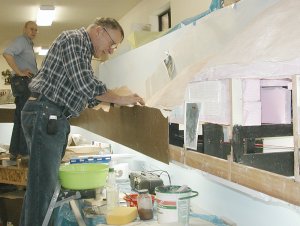
|
|
Bruce McGarvey works on a scene where the P&E climbs the grade out
of Butte Falls towards Summit. He's applying plaster cloth to the
foam land forms. Behind him, at Summit, Art McKee plans his
mountain logging scene.
|

|
|
Art McKee spent a career with the U. S. Forest Service so it's only
logical that he want to model a forest and logging scene. Here
he's smearing plaster over pink foam which he had carved into
terrain. Next will be ground cover, then trees. This
scene is on the logging branch just above Summit
|
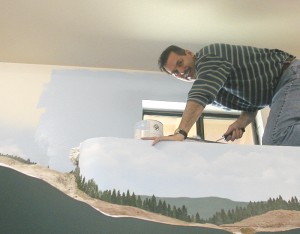
|
|
John Gerritsma is literally on
top of the world, painting the wall above Summit and Art's logging
scene sky blue. Initially we'd left the wall behind the
layout white, but realized this was a mistake. John rose to the
task of crawling above the "tunnel" behind the backdrop with roller and
brush to correct the oversight. Next, he'll return to his perch
with white paint and create fluffy clouds.
|
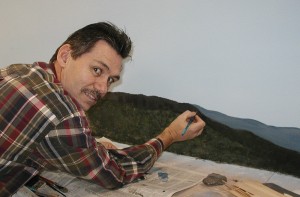
|
|
Back down to earth, John takes up artist's brushes and acrylics and
gets busy painting mountains on the backdrop. He's done an
outstanding job detailing the majority of the backdrops around the
layout and giving the railroad a sense of realism and continuity.
|
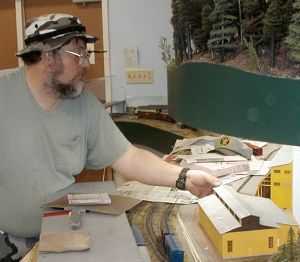
|
|
John
Powell shows off the model of the Medco engine house he built.
This structure was built from pictures of the original building and
selectively compressed to fit the scene. Many of the detail
parts, including the louvers in the clerestory, are not available
commercially and John crafted them by hand. While this scene is
compressed significantly, the location of the engine house relative to
adjacent buildings has been preserved.
|
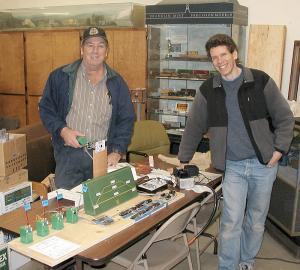
|
|
Jay
Mudge (left) and Ed Kleinman designed and built a board to test and
demonstrate the use of both a control panel and radio throttle to throw
turnouts. The four Tortoise switch motors wave little blue flags
back and forth as they're activated by the either the green panel
nearby or a Digitrax throttle. The experiment was deemed a
success and the Pacific & Eastern now features main line and
staging yard turnouts which are controlled remotely.
|
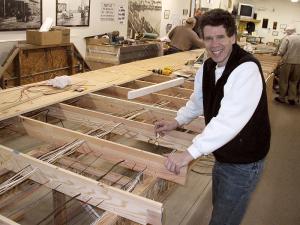
|
|
Ed's
suggestion to run wires for DCC buses, signal detection, signal
operation, loconet and "other" was taken to heart. We spent
three weeks planning, drilling and running wire before Ed pronounced
the under table wiring complete. While this seemed to slow layout
construction down considerable, that time will be more than saved when
the time comes to connect the track, signals and interior lights.
In this picture, Ed is inspecting our work and offering an suggesting
an occasional correction to the wiring plan.
|



